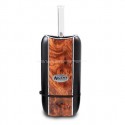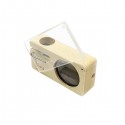
With the rapid advancement of vaporizers in the last couple of years, new vaping tools are beginning to take shape. Most of these will fall into the category of either desktop, portable or vaporizer pen. Wondering which one is right for you? Let this guide lead you to the light.
Desktop Vaporizers
 Think of desktop vaporizers as the early versions of desktop computers. The originals of vaping, desktop units were the first to hit the market, and while not exactly portable, their vaporization power is unmatched. The modern trend in vapes is to incorporate a design that looks great and acts as centerpiece at home.
Think of desktop vaporizers as the early versions of desktop computers. The originals of vaping, desktop units were the first to hit the market, and while not exactly portable, their vaporization power is unmatched. The modern trend in vapes is to incorporate a design that looks great and acts as centerpiece at home.
Desktop vaporizers come in two types: Whip-style, and forced air. Desktop vapes with a whip maintain the traditional experience one might expect from a vaporizing unit--simply put the glass mouthpiece to your lips and inhale. Forced air vaporizers do away with unnecessary inhaling and do the work for you. Vape into the future as the fans fill a bag with sweet vapors--way to go McFly. If you can’t make up your mind between forced air or whip, there are some systems that even offer dual distribution (check out the Arizer Extreme Q).
Desktop vaporizers also feature more precise temperature controls, allowing users to see the temperature the unit is operating at, and select their preferred temperature cut off, to the exact degree. This allows the greatest efficiency in vapor production, enabling you to alter the thickness of the vapor the unit produces.
Portable Vaporizers
 The difference between portable vaporizers and vape pens are less apparent at first. Sticking with the computer analogy, think of portable vapes as your laptop, and pen vapes as a tablet, while one’s good for quick use, it lacks the full feature set. Both however, lend themselves to taking your vape to the street--or wherever.
The difference between portable vaporizers and vape pens are less apparent at first. Sticking with the computer analogy, think of portable vapes as your laptop, and pen vapes as a tablet, while one’s good for quick use, it lacks the full feature set. Both however, lend themselves to taking your vape to the street--or wherever.
Another important distinction is the heating method. Convection style heating is the traditional engine of vaporizers, in which heated air is the catalyst for your vaporization materials. This prevents the materials from coming in contact with the heating source, producing no smoke. This creates a smoother, healthier hit; the essence of “true” vaping. Vape pens generally feature conduction style heating, which places the contents of your vaporizer in direct contact with the heating source. While efficient, this method can lead to inconsistencies in the vaporizing experience and can even lead to combustion (smoke).
Portable Vaporizers are more robust in design and tend to feature the newest vaping conventions and distinct styles. Options like the Firefly vaporizer are not only visually stunning but provide a vaping experience nearly as good as their desktop counterparts.
Pen Vaporizers
Vaping pens are the most widely seen vaporizers in the vapor world and are a good entry point for beginning vaping. These units all feature conduction style heating, so some combustion may occur. The construction of the unit is simple. First there’s a battery that charges the heating unit (the heating unit is where you’ll load your materials). Attached is the mouthpiece, from which you’ll inhale that sweet, milky vapor. Control of the device is normally delegated to a single button, which will perform all the essential functions.
While the above vaporizer types can accept both dry materials, and their more concentrated counterparts, most vape pens are optimized for concentrate use. While some may be adaptable for dry material, you will need to buy an alternate heating unit to accommodate it.
In summation, the form factor and feature set are the main distinctions between different vapes. Which tool is right for the job? That all depends on where you plan on vaping, what you plan to vape and the quality of the vapor you would like to inhale. You wouldn’t drive a Ferrari on a country road, right? Choose the right vaporizer for you. Vape on.















